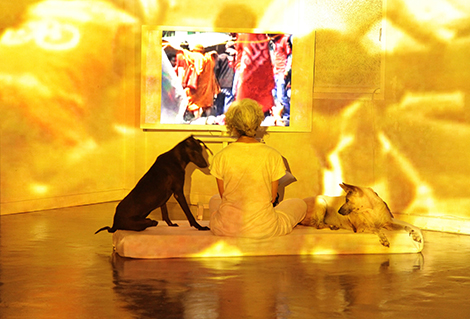Thai artist Araya Rasdjarmrearnsook’s retrospective at SculptureCenter in Queens, New York, and her concurrent solo exhibition at the Tyler Rollins Gallery titled “Niranam” is the work of a profound humanist. Using videos as her primary medium, she tackles subjects such as death, cruelty to animals, and the underrepresented rural population of Thailand with unusual perspicacity. What might fleetingly appear to be the work of a sentimentalist is quickly transformed into deeply stirring presentations mediated by nuance and restraint.
While Rasdjarmrearnsook’s practice is deeply informed by Thai culture and Buddhist beliefs, her long established place as a feminist who uses the body to negotiate new pathways resonates with universal overtones. The artist is perhaps best known for her “Class” and “Conversation” video series, in which her dialogue with corpses on gurneys in make-believe classroom settings are chillingly dignifying. Although these series are often interpreted in the Buddhist tradition as gestures of longing for the departed, bringing the discomfort of death into daily discourse is unexpectedly gratifying. Through philosophical conversations tinged with humor and affection, Rasdjarmrearnsook half-coaxingly elicits their feelings about funeral music, people crowding their coffins, and the circumstances and gravity of their passing. By anthropomorphizing death through her classroom sessions, the artist transposes the status of the dead, as she elevates the position of women in her culture.
Similarly, in Rasdjarmrearnsook’s deeply biographical video Niranam (2008), which translates as nameless or anonymous, her body becomes an important tool of intervention. A gruesome surgery is performed on her back as she narrates the early loss of her mother and the tribulations of growing up, interspersed with vivid memories of a riverbank, flowers and church bells. This method of repeatedly juxtaposing contrasting views and images throughout her art prevents it from sliding into mawkish sentiment.

Araya Rasdjarmrearnsook, The Treachery of the Moon (2012), Courtesy of the artist and Tyler Rollins Fine Art.
Infused by a deep sense of compassion for the vulnerable that is in keeping with Buddhist beliefs, Rasdjarmrearnsook honors the disenfranchised whether they are man or beast. The artist dedicates many of her works to stray dogs she rescues that otherwise are likely to be caught and killed. In The Treachery of the Moon (2012), these sentient creatures become Rasdjarmrearnsook’s companions. In the video, two dogs on a mattress in an empty room flank the artist as she watches an opulent soap opera. Bathed in exuberant waves of reds and oranges from the television, the room exudes a sense of rapture that seems to beatify the artist’s canine compatriots.
Rasdjarmrearnsook celebrates Thai villagers’ enthusiasm when a Buddhist monk elicits responses to paintings by Artemisia Gentileschi’s Judith Beheading Holfernes and Jeff Koons’ Untitled, of flamboyant bikini-clad women idolizing a man. By bringing her subjects to the forefront through a series of encounters with Western art, Rasdjarmrearnsook recognizes their presence.
Time and again, in an act of great reversal, the marginalized take center stage on a platform that brings them sensation and life. Placed in the hands of a gifted transformer, they remain etched in one’s memory forever.


